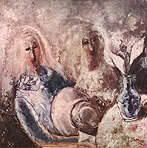Painting is the most genuine expression
of fine arts on the island. It could not develop in a coherent
manner because its first expressions, made by the aborigines
in the caves, were discontinued when those communities disappeared.
With the conquest and evangelisation process a religious
kind of painting prevailed, associated to catholic liturgy.
Only in the 19th century, when the San Alejandro academy
was founded (1818), paintings by natives began to flourish,
designed to satisfy the European taste of Cuban bourgeoisie.
The Economic Association Friends of the Country created
the Academy and its first principal was French painter Jean
Bautiste Vermay. By 1880 a new tendency in Cuban painting
was born, its main subject was landscapes. Outstanding in
this period were Esteban Chartrand and Valentin Sanz Carta.
The works of Basque Victor Patricio de Landaluze showed
an interesting folkloric style. But classicism still ruled
in fine arts. The avant-gardist awakening of the '20s (20th
century) initiated a new period for Cuban painting. The
modern movement had its first and most important exhibit
in 1927, sponsored by the magazine Avance. Eduardo Abela,
Victor Manuel, Antonio Gattorno, Carlos Enriquez and others
were starters of the vanguardist movement in Cuba. Following
years were of consolidation of the modern movement; this
was evidenced at the celebration of the First Modern Arts
Salon on 1937. Then, young artists already showed a new
period in Cuban art that would build up to create, the so-called
"School of Havana" in 1940.
Painters like Rene Portocarrero, Amelia
Pelaez and Mariano Rodriguez are part of this movement.
Wilfredo Lam returned to Cuba in 1942 after a long stay
in Europe and a studio experience with Pablo Picasso. On
1943 Lam painted the work that immortalised him "The Jungle",
which was acquired by New York's MOMA. With the triumph
of the revolution, the artistic movement strengthened, since
the foundation in 1962 of the National School of Fine Arts.
Very important personalities such as Raul Martinez and Antonia
Eiriz formed the body of professors. A few years later,
in 1976, the Fine Arts College of the High Institute of
Arts was founded. The important patrimony of the last decade
gathers works of artists like Roberto Fabelo, Zaida del
Rio, Tomas Sanchez, Manuel Mendive and Nelson Dominguez.
Young artists such as, Jose Bedia, Kcho and Flavio Garciandia
have occupied a privileged spot ahead of the new styles
of painting. During the last 30 years Cuban painting has
shown great capability to undertake the more important influences
from the international arts, with a creative and unique
appearance, assuming at the same time a critic attitude
to continue defending the characteristic features of the
Cuban identity.
Cuban artist today are abundant, they provide
a mixture of past and future conceptions that are creating
a worldwide attraction to the works. Art festivals and market
sales of these paintings can be found all over the country.
Who'll be the next Rembrandt? We will know in 100 years.












































